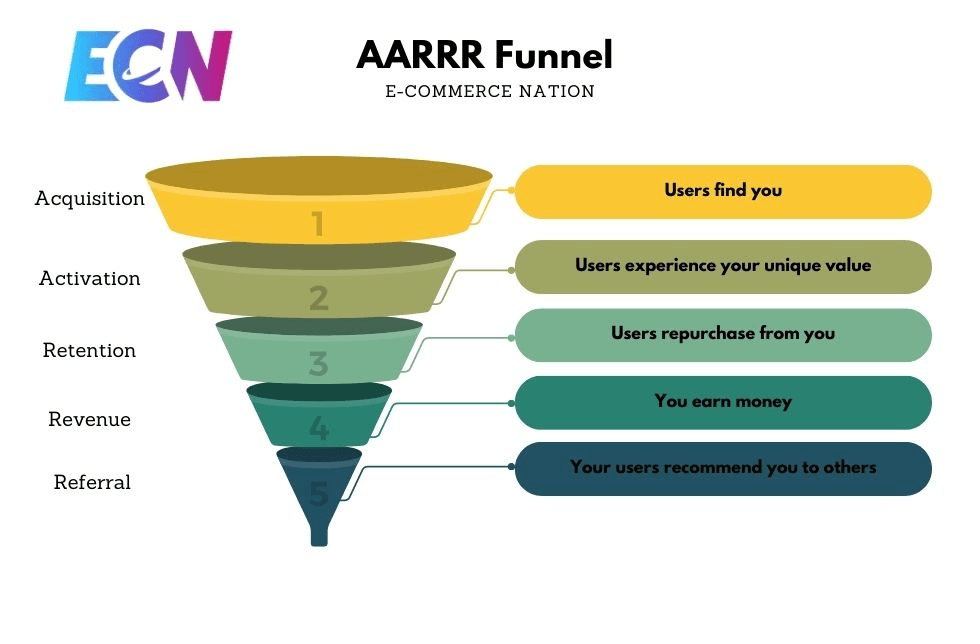Now, before we get going: yes, “AARRR” sounds like a pirate. No, it’s not about eye patches. AARRR Metrics are a simple way to track the whole customer journey: Acquisition, Activation, Retention, Referral, Revenue. Dave McClure cooked it up so teams stop arguing about vibes and start fixing what actually breaks.
You want more than traffic. You want people to show up, get value, stick around, tell a friend, and pay you without you having to sell a kidney to fund ads. That’s AARRR. Let’s walk the stages, keep the facts straight, and make it digestible enough that you could explain it to your cousin who still uses a Hotmail account.
Acquisition
What people assume: “More traffic solves everything.”
Reality check: If 10,000 visitors show up and none sign up, congrats, you just bought yourself a busy lobby.
What it is: The first touch. Website visit, app install, email click, free trial sign-up. They haven’t paid yet, but they raised a hand.
Track it with: sessions, unique visitors, ad clicks, sign-ups or leads, CTR, CPC, CPA, CAC. In Google Analytics, check Acquisition → All Traffic → Source/Medium to see which channels actually bring the right people. Ad platforms give you CTR, CPC, conversion rate. A CRM tells you which campaign pulled in which lead.
So what do you do with that:
All right, find where your best prospects come from and stop lighting money on fire. If organic search is sending high-intent folks while a certain social campaign has a CAC that makes you sweat, shift the budget. Quantity and quality, both. Brian Balfour and the growth crowd harp on this for a reason.
My take: If Facebook Ads are converting at 5 percent at a sane CPA, keep it. If a cute Instagram campaign looks good but costs you more per lead with worse conversion, cut it. Vanity metrics are for press releases. You need sources that send people who actually sign up.
What you’re probably thinking: “But I need awareness.” Sure. Just measure it so awareness doesn’t become “we spent five grand and got nothing but a nice graph.”
When you’re working on Acquisition, it’s not just about chasing every possible lead. For local agencies, focusing your efforts on the right geographic area can dramatically cut acquisition costs and improve results. If you want a deeper dive into this idea, check out my guide on Local Agency Marketing Strategy: Stop Chasing Every City and Start Owning Your County.
Activation
What people assume: “They signed up, so they’re sold.”
Reality check: Most sign-ups poke around, get confused, then ghost you like you asked them to help you move.
What it is: The “aha” moment. The first time a user actually gets value. For SaaS, maybe they complete onboarding or create their first project. For ecommerce, first purchase counts.
Track it with: sign-up to key action conversion, time to value, first-week engagement, feature usage. Tools like Mixpanel or Amplitude are built for this. GA can track events and goals too.
Examples that actually happened:
- Facebook saw that new users who added 7 friends in 10 days stuck around. Different docs say 7; I’ve seen folks debate it. I’m not tattooing the number; it’s in that neighborhood.
- Slack found teams that hit around 2,000 messages basically never churned. Once the chat is humming, they’re not leaving.
- Dropbox discovered most sign-ups didn’t upload a file. Zero out of five in a usability test got through setup. Painful. They fixed 80-plus friction points and activation climbed.
What to do:
I mean, find your magic moment and shove people toward it. Tutorials, tooltips, drip emails, simpler forms. If 60 percent of sign-ups stall on the welcome screen, that’s on you, not them.
A quick aside: I’ve built onboarding that asked for everything but a blood type. Shockingly, activation stunk. We cut fields, added a nudge, and boom, more folks actually used the thing. I still have regrets. I got a few.
Retention
What people assume: “We’ll just buy more users.”
Reality check: If your bucket leaks, pouring faster just makes a wetter floor.
What it is: Do people stick around and use it again, or do they vanish after day one? Cheaper to keep a customer than to keep replacing them. Obviously.
Track it with: retention rate, churn, DAU/MAU, repeat purchase rate, session frequency, Customer Lifetime Value. Do cohort analysis to see how each week’s users behave over time. You want that curve to flatten, not nosedive.
How to help it:
Personalized emails, helpful push notifications, loyalty perks, solid support. Trigger messages by behavior: “haven’t logged in for a week,” “hit a milestone,” “abandoned cart.” If logins drop or session time shrinks, that’s an early churn siren; reach out with something useful, not “hey bestie.”
Objection I hear a lot: “Isn’t this product’s job, not marketing?” Yes and no. Product needs to deliver value. Marketing needs to keep that value top-of-mind and get people back to it. It’s a relay race.
Blue-collar truth: If the tool keeps breaking, folks won’t use it. If it works and you remind them why it helps, they’ll keep it in the truck.
Referral
What people assume: “Great products sell themselves.”
Reality check: They can, if you make sharing easy and give folks a reason.
What it is: Happy users invite others. Word-of-mouth, invite links, referral codes, reviews. If your referral engine hums, acquisition costs drop. That’s not theory; it’s math.
Track it with: invites sent, invite conversion rate, percent of new users from referrals, redeemed referral credits, viral coefficient. NPS tells you who’s likely to recommend you, even if it doesn’t count referrals directly.
What works:
- Dropbox offered extra storage to both sides for each referral. People loved free space. Sign-ups exploded without a giant ad bill.
- Add referral CTAs right after a win: completed an order, finished onboarding, hit a milestone. “Invite a friend, get X.”
- Use unique links or codes so you know who sent whom. Basic stuff, but lots of teams skip it.
If this flops: Your experience isn’t impressive yet, or the incentive is weak, or sharing is hidden. Fix the product, sweeten the deal, and put the button where humans can see it.
Revenue
What people assume: “If we keep them engaged, the money comes.”
Reality check: Not unless pricing, packaging, and the upgrade path make sense.
What it is: Money in the door from all that work upstream. For subscriptions, think MRR, ARPU, conversion rate to paid, revenue growth, payback period, LTV vs CAC.
Track it with: GA ecommerce tracking for stores; Stripe or Chargebee for subs; CRM for campaign ROI; revenue cohorts for Net Dollar Retention.
How to move it:
- Improve conversion: tighten the pricing page, simplify checkout, try free trial length, test CTAs. Klipfolio tweaked pricing and saw better conversions. You can test your way there.
- Monetize smarter: upsell, cross-sell, add a premium tier. Freemium can work if activation and retention are solid.
- Watch CAC vs LTV like a hawk. If you pay $100 to acquire a customer who pays $50 total, that is not “brand building.” That is losing money.
Quick Q&A:
Q: “Should we add ads to the free plan?”
A: Maybe, if it doesn’t wreck the experience and the math pencils out. Try it, measure it, keep what pays.
How to actually use AARRR in campaigns
1) Map your funnel:
Write down what each stage means for your business. Example for SaaS: Acquisition = website sign-up, Activation = onboarding completed, Retention = weekly active use, Referral = invites sent, Revenue = upgrade. Label channels by stage. SEO is usually Acquisition. Email newsletters often do Retention. Don’t overthink it, just be consistent.
2) Pick metrics and wire up tracking:
Choose a few KPIs per stage and instrument them. GA goals, app events in Mixpanel or Amplitude, CRM fields for repeat purchases. What gets measured gets managed. Build a dashboard that shows stage-to-stage conversion by cohort.
3) Tie campaigns to stages:
Every campaign should declare which stage it’s meant to move and how you’ll judge it. A webinar? Sure, target attendees for Acquisition and trial starts for Activation. Set both targets up front.
4) Hunt bottlenecks:
If Acquisition is fine but Activation is weak, stop buying more traffic and fix onboarding. If Activation is great and month-one Retention falls off a cliff, address ongoing value. Funnel math will tell you where the leak is.
5) Iterate like you mean it:
Measure → analyze → act → repeat. Try new channels if Acquisition is soft. Shorten “time to value” if Activation lags. Nudge behavior if Retention dips. Launch a real referral program if sharing is flat. Test pricing if Revenue disappoints. Personalize across the board when you can.
Real companies that used this playbook
Dropbox:
- Activation was broken. Usability tests showed 0 out of 5 newbies could complete basic tasks. They listed more than 80 friction points, fixed them, and activation climbed.
- Referral was the growth engine. Two-sided storage rewards turned users into recruiters. Sign-ups surged while acquisition costs stayed low.
- Acquisition hacks helped early. A scrappy demo video in the right communities built a big waitlist basically for free.
Slack:
- They found a sticky threshold: teams that sent around 2,000 messages almost never churned. So the product and onboarding push teams to invite coworkers and actually chat.
- They tracked messages sent in week one, channels created, integrations added. Drive those up, retention follows. Simple, not easy.
Facebook:
- “7 friends in 10 days” predicted long-term use. They redesigned onboarding to help you find people fast: People You May Know, contact imports, constant prompts. Activation rose, retention followed, and referrals piggybacked on social circles. Different sources debate exact numbers. I don’t care if it’s 7 or 8; the point stands.
Stage-by-stage tune-ups you can try next week
Acquisition: test targeting, creative, and landing pages. Kill channels with ugly CAC. Keep the ones that send people who activate.
Activation: shorten forms, add tooltips, trigger welcome emails, highlight the one action that correlates with success. Segment by source to see who activates best and mirror that messaging.
Retention: behavior-triggered emails or pushes, helpful content, proactive support. Ask churned users why they left; fix the top reason. Celebrate loyal users; learn from them.
Referral: add visible “invite” spots, time the ask after a win, use two-sided rewards, track with codes. Nudge your NPS promoters to share.
Revenue: test pricing clarity, remove checkout friction, add reasonable upsells, monitor payback period. If ARPU slides, figure out if discounts, smaller customers, or a messy tier are to blame.
Final word, straight up
Metrics are not the goal. Happy customers who buy, stay, and bring friends are the goal. AARRR just keeps you honest so you stop guessing and start fixing the right thing. Track each stage, find the leak, patch it, and keep moving. Even the heavy hitters did it this way. You can too.
Spoiler alert: if you actually run this loop and don’t quit after week one, your funnel stops looking like a colander and starts acting like a pipeline. And when your grocery bill looks like a car payment, profitable growth feels pretty good.

